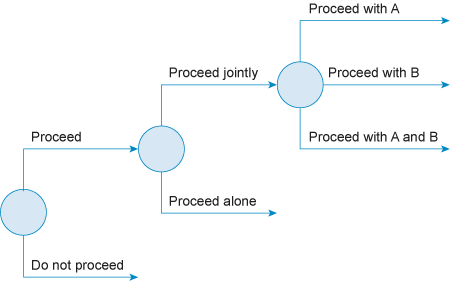2.5 Decision trees
A decision tree is usually used to depict the options or various courses of actions available for solving a problem. This allows the relationships between options to be clarified, revealing the different decision points and the levels that exist. If something goes wrong, the decision can be re-examined and the point at which the wrong option was chosen can be identified.
Box 2 Example of a decision tree
A young manager had an idea for what seemed to be a potentially profitable business opportunity. He discussed it separately with two business acquaintances, both of whom expressed enthusiasm. One had money. The other had relevant expertise and a small company that might be used to nurture the venture, but also represented a threat.
The young man was struggling to sort out how best to proceed; he had about six alternatives in his head but had not separated them out clearly. Each time he started to think about any one of them, he would quickly switch to others and end up going round in circles.
Then he produced a decision tree as shown in Figure 6. This was no more than a diagram of his options but it helped him to clarify them in his mind and he was able to think them through. Before a decision is made, each of the options must be evaluated and the possible outcome predicted.
Options can also be weighted to indicate probability.

